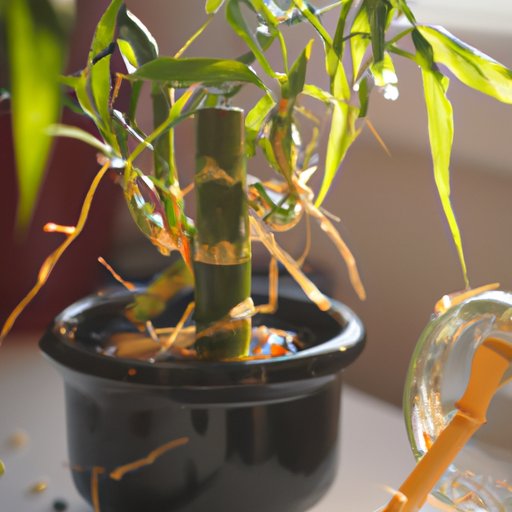Introduction
Bamboo plants are a beautiful addition to any home or office. Not only do they look great, but they’re also low maintenance and can help purify the air. If you’ve recently acquired a bamboo plant, this article will provide helpful tips on how to care for it properly.
Providing Adequate Sunlight
Bamboo plants need plenty of sunlight to grow and thrive. They should be placed in a spot that gets bright, indirect light throughout the day. Avoid putting them in direct sunlight, as this can cause the leaves to burn. If your bamboo plant is not receiving enough sunlight, it may become leggy and weak.
Watering Regularly
Bamboo plants need to be watered regularly to stay healthy. Water the soil until it is evenly moist, but be careful not to overwater. You should water your bamboo plant once every week or two, depending on the climate and season. Make sure to allow the top inch of soil to dry out before watering again.
Placing in a Well-Draining Pot
It’s important to place your bamboo plant in a pot with drainage holes. These allow excess water to escape and prevent the roots from becoming waterlogged. Choose a pot with a size and material that suits your bamboo plant’s needs. Plastic and ceramic pots work well, but make sure they have good drainage.
Feeding Monthly
To ensure that your bamboo plant stays healthy and vigorous, you should feed it a balanced fertilizer once a month. Use a liquid fertilizer designed specifically for bamboo plants, or use a general-purpose fertilizer diluted to one-quarter strength. Be careful not to overfertilize, as this can damage the plant.
Pruning Regularly
Regular pruning helps keep your bamboo plant looking its best. Remove any yellowing leaves or dead stalks to encourage new growth. Prune the plant back to the desired shape and size, taking care to avoid cutting off too much at once. Prune your bamboo plant at least once a year.
Monitoring for Pests
Keep an eye out for signs of pests such as aphids, mealybugs, and scale insects. If you notice any of these, treat the plant with an appropriate insecticide. Be sure to follow the instructions carefully, and always wear protective gloves when handling pesticides.
Repotting Occasionally
Over time, your bamboo plant may outgrow its pot. When this happens, it’s time to repot. Choose a pot that’s slightly larger than the previous one, and add a layer of fresh potting soil. Carefully remove the plant from its old pot and transfer it to the new one. Make sure to water the plant thoroughly after repotting.
Conclusion
Caring for a bamboo plant can be easy if you know the basics. Provide adequate sunlight, water regularly, place in a well-draining pot, feed monthly, prune regularly, monitor for pests, and repot occasionally. With proper care, your bamboo plant will thrive and bring beauty to your home or office.


